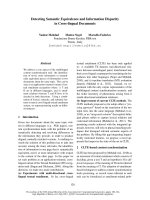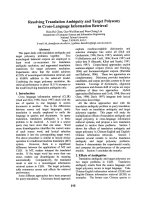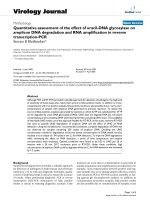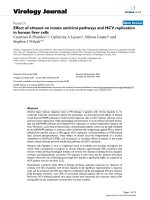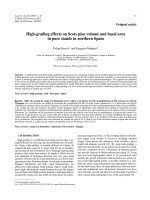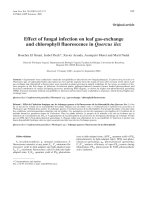On resolving semantic heterogeneities and deriving constraints in schema integration
Bạn đang xem bản rút gọn của tài liệu. Xem và tải ngay bản đầy đủ của tài liệu tại đây (1.08 MB, 231 trang )
ON RESOLVING SEMANTIC
HETEROGENEITIES AND DERIVING
CONSTRAINTS IN SCHEMA INTEGRATION
QI HE
(B.Sc., Fudan University)
A THES IS SUBMITTED
FOR THE DEGREE OF DOCTOR OF PHILOSOPY
DEPARTMENT OF COMPUTER SCIENCE
SCHOOL OF CO MPUTING
NATIONAL UNIVERSITY OF SINGAPORE
2005
ii
Abstract
A challenge in schema integration is schematic discrepancy, i.e., meta information
in one d atabase correspond to d ata values in another. The p urposes of this work
were to resolve schematic discrepancies in the integration of relational, ER and
XML schemas, and to derive constraints in schema transformation in the context
of schematic discrepancies.
In the integration of relational schemas with schematic discrepancies, a theory
of schema transformation was developed. The theory was on the properties (i.e.,
reconstructibility and commutativity) of schema-restructuring operators and the
properties (i.e., information preservation and non-redundancy) of schema transfor-
mation.
Qualified functional dependencies which are functional dependencies holding
over a set of relations or a set of horizontal partitions of relations were proposed to
represent constraints in heterogeneous databases with schematic discrepancies. We
proposed algorithms to derive qualified functional depend encies in schema transfor-
mation in the context of schematic discrepancies. The algorithms are sound, com-
plete and efficient to derive some qualified functional depend encies. The theory of
qualified functional dependency derivation is useful in data integration/mediation
systems and multidatabase interoperation.
iii
In the integration of ER schemas which are more complex than relational
schemas, we resolved schematic discrepancies by transforming the meta information
of schema constructs into attribute values of entity types. The schema transforma-
tion was p roven to be both information preserving and constraint preserving.
The resolution of schematic discrepancies for the r elational and ER models
can be extended to XML. However, the hierarchical structure of XML brings new
challenges in the integration of XML schemas, which was the focus of our work. We
represented XML schemas in the Object-Relationship-Attribute model for Semi-
Structured data (or ORASS). We gave an efficient method to reorder objects in a
hierarchical path, and proposed a semantic approach to integrate XML schemas,
resolving the inconsistencies of hierarchical structures. The algorithms were proven
to be information preserving.
We believe this research has richly extended the theories of schema transfor-
mation and the derivation of constraints in schema integration. It may effectively
improve the interoperability of heterogeneous databases, and be useful in build-
ing multidatabases, data warehouses and information integration systems based on
XML.
iv
Acknowledgement
First of all, I would like to thank my supervisor Prof Ling Tok Wang. He taught
me the way of research and presentation, and the spirit of continuous improvement.
As a researcher, he is a man of insight and experience. His comments are always
suggestive and pertinent. As a supervisor, he is patient and strict. It’s lucky but
not easy t o be his student. He leads me along the way here. Without his help, the
thesis would never have been come into being.
Thank Dr. St´ephane Bressan and Dr. Chan Chee Yong for the effort and time
to read the thesis and the valuable comments based on which I improved the thesis
much.
Thank Prof Zhou Aoying and Prof Ooi Beng Chin. They provided me with the
opportunity to pursue the PhD degree in Singapore.
I am also thankful to my colleagues in SoC and all my friends in Singapore: Chen
Ding, Chen Ting, Chen Yabin, Chen Yiqun, Chen Yueguo, Chen Zhuo, Cheng Wei-
wei, Dai Jing, Ding Haoning, Fa Yuan, Fu Haifeng, Hu Jing, Huang Yang, Huang
Yicheng, Jiao Enhua, Li Changqing, Li Xiaolan, Li Yingguang, Liu Chengliang,
Liu Shanshan, Liu Xuan, Lu Jiaheng, Ni Yuan, Pan Yu, Sun Peng, Wang Shiyuan,
Wang Yan, Xia Chenyi, Xia Tian, Xiang Shili, Xie Tao, Xu Linhao, Yang Rui,
Yang Xia, Yang Xiaoyan, Yang Tian, Yao Zh en, Yu Tian, Yu Xiaoyan, Zhang Han,
v
Zhang Wei, Zhang Xiaofeng, Zhang Zhengjie, Zheng Wei, Zheng Wenjie, Zhou
Xuan, and Zhou Yongluan. Thank them not only for the help and encouragement,
but also for the dispute. The friendship among us will be a treasure in my life.
Special thanks go to my friend Ni Wei for his warm heart and wisdom. He
pushed me when I hesitated, guided me when I was lost and accompanied me when
I was hurt. With self discipline, he can be something one day. I have no doubt
about that.
Finally, thank my parents. They are always at my back no matter what I do.
Contents
Abstract ii
1 Introduction 1
1.1 Schematic discrepancies by examples . . . . . . . . . . . . . . . . . 5
1.2 Functional dependencies in multidatabases . . . . . . . . . . . . . . 9
1.3 Objectives and organization . . . . . . . . . . . . . . . . . . . . . . 11
2 Preliminaries 14
2.1 ER approach . . . . . . . . . . . . . . . . . . . . . . . . . . . . . . 15
2.2 ORASS approach . . . . . . . . . . . . . . . . . . . . . . . . . . . . 16
3 Literature review 24
3.1 Restructuring operators and discrepant schema transformation . . . 24
3.2 Data dependencies and the derivation of constraints in schema trans-
formation . . . . . . . . . . . . . . . . . . . . . . . . . . . . . . . . 27
3.3 Resolution of stru ctural conflicts in the integration of ER schemas . 32
3.4 XML schema integration and data integration . . . . . . . . . . . . 32
3.5 Ontology merging . . . . . . . . . . . . . . . . . . . . . . . . . . . . 35
3.6 Model management . . . . . . . . . . . . . . . . . . . . . . . . . . . 36
vi
vii
4 Knowledge gaps and research problems 38
4.1 Theory of discrepant schema transformation . . . . . . . . . . . . . 38
4.2 Representing, deriving and using dependencies in schema transfor-
mation . . . . . . . . . . . . . . . . . . . . . . . . . . . . . . . . . . 39
4.3 Resolving schematic discrepancies in the integration of ER schemas 41
4.4 Resolving hierarchical inconsistency in the integration of XM L schemas 43
5 Lossless and non-redundant schema transformation 48
5.1 Algebraic laws of rest ructur ing op er ators . . . . . . . . . . . . . . . 48
5.1.1 Reconstructibility . . . . . . . . . . . . . . . . . . . . . . . . 49
5.1.2 Commutativity . . . . . . . . . . . . . . . . . . . . . . . . . 53
5.2 Lossless and non-redundant transformations . . . . . . . . . . . . . 54
5.3 Summary . . . . . . . . . . . . . . . . . . . . . . . . . . . . . . . . 58
6 Deriving and using qualified functional dependencies in multi-
databases 60
6.1 Qualified functional dependencies . . . . . . . . . . . . . . . . . . . 61
6.1.1 Definition of qualified functional dependency . . . . . . . . . 61
6.1.2 Inference rules of qualified functional dependencies in fixed
schemas . . . . . . . . . . . . . . . . . . . . . . . . . . . . . 62
6.1.3 Compute attribute closures with respect to qualified func-
tional dependencies . . . . . . . . . . . . . . . . . . . . . . . 65
6.2 Deriving qualified fu nctional dependencies in schema transformations 69
6.2.1 Propagation rules . . . . . . . . . . . . . . . . . . . . . . . . 69
6.2.2 Deriving qualified functional dependencies in discrepant schema
transformations . . . . . . . . . . . . . . . . . . . . . . . . . 73
viii
6.2.3 Complexities of Algorithms EFFICIENT
PROPAGATE and
CLOSURE . . . . . . . . . . . . . . . . . . . . . . . . . . . 78
6.3 Uses of qualified functional dependency derivation . . . . . . . . . . 83
6.3.1 Deriving qualified functional dependencies in data integra-
tion/mediation systems . . . . . . . . . . . . . . . . . . . . . 83
6.3.2 Verifying SchemaSQL views . . . . . . . . . . . . . . . . . . 85
6.4 Summary . . . . . . . . . . . . . . . . . . . . . . . . . . . . . . . . 89
7 Resolving schematic discrepancies in the integration of ER schemas 91
7.1 Meta information of schema constructs . . . . . . . . . . . . . . . . 91
7.2 Resolution of schematic discrepancies in the integration of ER schemas 98
7.2.1 Resolving schematic discrepancies for entity types . . . . . . 99
7.2.2 Resolving schematic discrepancies for relationship types . . . 110
7.2.3 Resolving schematic discrepancies for attributes of entity types113
7.2.4 Resolving schematic discrepancies for attributes of relation-
ship typ es . . . . . . . . . . . . . . . . . . . . . . . . . . . . 115
7.3 Semantics preserving transformation . . . . . . . . . . . . . . . . . 117
7.3.1 Semantics preservation of Algorithm ResolveEnt . . . . . . . 118
7.4 Schematic discrepancies in different models . . . . . . . . . . . . . . 119
7.4.1 Representing and resolving schematic discrepancies: from the
relational model to ER . . . . . . . . . . . . . . . . . . . . . 119
7.4.2 Extending the resolution in the integration of XML schemas 121
7.5 Summary . . . . . . . . . . . . . . . . . . . . . . . . . . . . . . . . 123
8 Resolving hierarchical inconsistencies in the integration of XML
schemas 125
8.1 Use cases an d criteria of XML schema integration . . . . . . . . . . 126
ix
8.2 XML schema integration: using ORASS . . . . . . . . . . . . . . . 128
8.3 Reordering the objects in relationships . . . . . . . . . . . . . . . . 129
8.3.1 Reordering objects using relational databases . . . . . . . . 130
8.3.2 Cost model . . . . . . . . . . . . . . . . . . . . . . . . . . . 133
8.4 Merging relationship types . . . . . . . . . . . . . . . . . . . . . . . 138
8.4.1 Definitions . . . . . . . . . . . . . . . . . . . . . . . . . . . . 138
8.4.2 Algorithm . . . . . . . . . . . . . . . . . . . . . . . . . . . . 142
8.4.3 Evaluation of Algorithm MergeRel . . . . . . . . . . . . . . 149
8.5 XML schema integration by example . . . . . . . . . . . . . . . . . 150
8.6 Comparison with oth er approaches to XML schema integration . . . 154
8.7 Summary . . . . . . . . . . . . . . . . . . . . . . . . . . . . . . . . 157
9 Conclusion 159
9.1 Summary of contributions . . . . . . . . . . . . . . . . . . . . . . . 159
9.2 Future work . . . . . . . . . . . . . . . . . . . . . . . . . . . . . . . 163
A App endix 165
A.1 Commutativity of restructuring operations . . . . . . . . . . . . . . 165
A.2 Proof of Lemma 5.1 . . . . . . . . . . . . . . . . . . . . . . . . . . . 167
A.3 Proof of Lemma 5.2 . . . . . . . . . . . . . . . . . . . . . . . . . . . 169
A.4 Proof of Theorem 6.1 . . . . . . . . . . . . . . . . . . . . . . . . . . 170
A.5 Proof of Theorem 6.2 . . . . . . . . . . . . . . . . . . . . . . . . . . 177
A.6 Proof of Theorem 6.3 . . . . . . . . . . . . . . . . . . . . . . . . . . 179
A.7 Quick propagation rules and Algorithm EFFICIENT
PROPAGATE 180
A.8 Proof of Theorem 6.4 . . . . . . . . . . . . . . . . . . . . . . . . . . 185
A.9 Resolution algorithms of schematic discrepancies in the integration
of ER schemas . . . . . . . . . . . . . . . . . . . . . . . . . . . . . . 190
x
A.10 Proof of Theorem 7.2 . . . . . . . . . . . . . . . . . . . . . . . . . . 196
A.11 Proof of Theorem 8.2 . . . . . . . . . . . . . . . . . . . . . . . . . . 208
List of Figures
1.1 Schematic discrepancy: months and supplier numbers are modelled
differently in these databases . . . . . . . . . . . . . . . . . . . . . . 6
2.1 Dependencies in ER schema . . . . . . . . . . . . . . . . . . . . . . 16
2.2 ORASS schema diagram . . . . . . . . . . . . . . . . . . . . . . . . 18
2.3 ORASS instance diagram . . . . . . . . . . . . . . . . . . . . . . . . 18
2.4 Corresponding DTD and XML document sections . . . . . . . . . . 18
2.5 an ambiguous DTD corresponding to two ORASS schemas . . . . . 20
3.1 Transforming DB4 to DB5 with a set of fold operations, and the
converse with a set of unfold operations . . . . . . . . . . . . . . . . 26
3.2 Illustration of th e chase . . . . . . . . . . . . . . . . . . . . . . . . . 29
5.1 A lossy fold transformation: the transformation from R (I1 or I2) to
S is un-recoverable. . . . . . . . . . . . . . . . . . . . . . . . . . . . 50
6.1 Ambiguous SchemaSQL view: SupV iew may have one of the two
instances I1 an d I2 . . . . . . . . . . . . . . . . . . . . . . . . . . . 86
xi
xii
7.1 ER schemas and their contexts. Schematic discrepancies occur as
months and suppliers modelled differently as the attribute values or
metadata in DB1, DB2 and DB3 . . . . . . . . . . . . . . . . . . . 95
7.2 Resolve schematic discrepancies for entity types: handle attributes . 100
7.3 Resolve schematic discrepancies for entity types: handle relationship
types . . . . . . . . . . . . . . . . . . . . . . . . . . . . . . . . . . . 104
7.4 Resolve schematic discrepancies for relationship types . . . . . . . . 111
7.5 Resolve schematic discrepancies for attributes of entity types . . . . 113
7.6 Resolve schematic discrepancies for attributes of relationship types . 116
7.7 Two representations of the supply information in ORASS . . . . . . 121
7.8 Transforming Schema S2 to S1 . . . . . . . . . . . . . . . . . . . . . 122
8.1 Reorder S/P/M into P/S/M: first sort the table by P#, S#, M#,
then merge th e objets with the same id entifier values in the table . 131
8.2 XQuery statements to swap the elements SUPPLIER and PROD in
the XML document section of Figure 2.4 . . . . . . . . . . . . . . . 133
8.3 different ways to merge relationship types . . . . . . . . . . . . . . 139
8.4 Source schemas . . . . . . . . . . . . . . . . . . . . . . . . . . . . . 151
8.5 Intermediate integrated schema of S1 to S4 after Step 6 . . . . . . . 153
8.6 Integrated schema of S1 to S4 by our approach . . . . . . . . . . . . 153
8.7 Integrated schema of S1 to S4 by the approach of [74] . . . . . . . . 155
8.8 Integrated schema of S1 to S4 by the approach of [29] . . . . . . . . 157
1
Chapter 1
Introduction
Traditionally, database application uses software, called a database management
system managing a multitude of data located in one site. Modern applications
require easy and consistent access to multiple databases. A multidatabase system
(i.e., MDBS) addresses this issue. A MDBS is a collection of cooperating but
autonomous database systems (called component database systems). Such a system
provides controlled and coordinated manipulation of the component databases. In
building a MDBS, schema integration plays an important role. Schema integration
is the activity to integrate the schemas of existing or proposed databases into a
global, unified schema. Users can access the data of those component databases
through the integrated schema. The differences and inconsistencies of data models,
schemas and data among those databases are transparent to users.
A data warehouse is a “subject-oriented, integrated, time varying, non-volatile
collection of data that is used primarily in making decisions in organizations [28].”
Unlike a MDBS, a data warehouse contains consolidated data from several oper-
ational databases and oth er sources. However, similar information may be stored
in different schemas in source databases, schema integration is therefore a neces-
sary stage before data integration in which dup licate and inconsistency of data are
2
removed.
Another application of schema integration is view integration in database de-
sign. View integration is a process of producing a sch ema of a proposed database
by integrating different user views. There are two reasons for view integration in
database design: (1) the structure of database is too complex to be modelled in a
single view, and (2) user groups have their own requirements and expectations of
data. View integration is on schema level and usually processed during conceptual
database design.
As XML becomes more and more a de facto standard to represent and exchange
data in e- business, information mediation/integration based on XML provides a
competitive advantage to businesses [48]. XML schema integration is a necessary
stage in building an integration system for either transaction or analytical process-
ing purpose.
Correspondingly, schema integration can be divided into to 2 classes according
to the data models, one on flat models such as relational, ER or object-oriented
model, and the other one on hierarchical models such as XML. In general, in schema
integration, people usually need to resolve different kinds of semantic heterogenei-
ties:
• Naming conflict - Homonyms and synonyms are the two sources of naming
conflicts. Renaming is a frequently chosen solution in existing work.
• Key conflict - Different keys may be assigned as the identifier of the same
concept in different schemas. For example, attributes SSNO and EMPNO
may b e identifiers for the entity types of EMPLOYEE in two schemas.
• Structural conflict - The same real world concept may be represented in two
schemas using different schema constructs [4, 39 ]. For example, the same
3
concept publisher may be modelled as an entity type in one schema, but an
attribute in anoth er schema.
• Domain mismatch - Domain mismatch occurs when we have conflict between
the domains of equivalent attributes. E.g., the value set for an attribute
EXAM
SCORE may be in grades (A, B, C etc) in one database and in marks
in another database. Given the corresponding rules between the grades and
marks, we can resolve this kind of conflicts.
• Constraint conflict - Two schemas may represent different constraints on the
same concept [38]. For example, the conflict occurs on the cardinality con-
straints. For instance, PHONE
NO may be a single valued attribute in one
schema, but multi-valued in another schema. Another example involves dif-
ferent constraints on a relationship type such as TEACH. Assuming that in-
structors can teach more than one course, one schema may represent TEACH
as 1:n (a course has an instructor) and another schema may represent it as
m:n (some courses may have more than one instructors).
• Classification inconsi stency - hyponyms or hypernyms, i.e., an object class is
less or more general than another object class [10, 52].
• Schematic discrepancy - Schema construct names in one schema correspond
to attribute values in another. We will explain this kind of semantic incon-
sistency by an example in Section 1.1 below.
Furthermore, in the integration of XML schemas, we should also resolve the
inconsistency of hierarchical structures. For example, the same binary relationship
type between INSTRUCTOR and COURSE is represented as a path INSTRUC-
TOR/COURSE in one schema tree, i.e., listing the courses taught by each instruc-
4
tor, but COURSE/INSTRUCTOR in another, i.e., listing the instructors of each
course.
To integrate the schemas of sources in different models (e.g., the relational,
object-relational, network or hierarchical model), we should first translate them to
the same data model, e.g., the ER model, and then transform the ER schemas to
consistent ones in which semantic heterogeneities are resolved. At last, we integrate
the transformed schemas by mer ging the equivalent structures.
In schema transformation, we usually require that the original and transformed
schemas represent exactly the same real world facts, although with different mo-
delling constructs. A semantic preserving schema transformation is both informa-
tion preserving and constraint preserving. Informally, a transformation is informa-
tion preserving if any instance of the original schema can be losslessly converted
into an instance of the transformed schema, and vice versa. A transformation is
constraint preserving if th e constraints expressed in the original schema can also
be expressed in the transformed schema.
In this work, we studied the resolution of schematic discrepancies in the in-
tegration of relational or ER schemas, i.e., transforming schematically discrepant
schemas into consistent ones. We also studied the derivation of constraints (in par-
ticular, an extension to functional dependencies) in schema transformation. This is
significant because: (1) a sch ema transformation should be constraint preserving,
and (2) constraints are very useful in multidatabase systems. One of the interest-
ing points is that constraints (i.e., functional dependencies) can be used to verify
information preserving schema transformations. Note some semantic rich models
(e.g., ER) themselves support (cardinality) constraints. Then the derivation of
constraints is involved in schema transformation rather than a separate process.
In the integration of XML schemas, the new challenges come from the hierar-
5
chical structures of XML. The resolution of some semantic heterogeneities such as
naming conflicts and domain mismatches for the flat models (e.g., the relational
or ER model) can be adapted to the hierarchical model of XML directly. For
some other heterogeneities, e.g., structural conflicts and schematic discrepancies,
we should consider the hierarchical structures of XML in the resolution. Furt her-
more, besides all these heterogeneities, the inconsistency of hierarchical structures
may occur alone among XML schemas. Our solution is to separate the resolutions
of structural conflicts and schematic discrepancies from the handling of hierarchical
structures in the integration of XML schemas. That is, we first resolve the struc-
tural conflicts and schematic discrepancies using the resolutions similar to those
for the flat models in schema transformations, ignoring the hierarchical character-
istics of XML, and then resolve the inconsistencies of hierarchical structures in the
integration of the transformed schemas. We will focus on the second stage, i.e., the
resolution of the inconsistency of hierarchical structures, in the integration of XML
schemas.
In the rest of this section, we first introduce the semantic heterogeneity of
schematic discrepancy by an example in relational databases. Then we introduce
an extension of functional dependencies in multidatabases. Finally, we present the
objectives and organizations of this thesis.
1.1 Schematic discrepancies by examples
In relational databases, schematic discrepancy occurs when the same information
is modelled differently as attribute values, relation names or attribute names in
different databases, as shown in the example below. For ease of presentation, we
assume naming conflicts have been resolved if any. Furthermore, we assume that
6
the same information is represented in the same form when it is the attribute values,
the relation names or the attribute names in databases.
Example 1.1. In Figure 1.1, we give four databases DB1 to DB4 recording the
same information: supplying prices of products (identified by p#) by suppliers
(identified by s#) in different months. In DB1, all the information, i.e., prod-
uct numbers, supplier numbers, months and prices are modelled as attribute values.
In DB2, the months Jan, . , Dec are attribute names whose values are prices i n
those months; in DB3, each relation with a month as its name records the supply-
ing information in that month; in DB4, each relation with a supplier number as
its name records products’ prices in each month by that supplier.
unfold( Supply, month, price )
fold( Supply, month, price )
split( Supply, month ) unite({j an,...,dec },month )
DB2:
Supply
DB1:
Supply
DB3:
jan
dec
{p#, s# } { jan, ..., dec }→
{p#, s#, month } price
→
{p#, s# } price holds in each
relation of jan , ..., dec
→
DB4:
s
1
s
n
p# { jan, ..., dec } holds in each
relation of s
1
, s
2
, ..., s
n
→
p# s# jan … dec
p
1
s
1
105 … 110
p
1
s
2
97 … 99
p# s# month price
p
1
s
1
jan 105
p
1
s
1
dec 110
p
1
s
2
jan 97
p
1
s
2
dec 99
... ... ... ...
p# s# price
p
1
s
1
105
p
1
s
2
97
p# s# price
p
1
s
1
110
p
1
s
2
99
p# jan … dec
p
1
105 … 110
split( Supply, s# )
unite({ s
1
,...,s
n
}, s# )
p# jan … dec
p
1
93 … 95
...
...
Figure 1.1: Schematic discrepancy: months and supplier numbers are modelled
differently in these databases
The schemas of Figure 1.1 are schematically discrepant from each other: the
7
values of the attribute month in DB1 correspond to attribute names of DB2 and
DB4, or relation names of DB3, and the values of the attribute s# in DB1 cor-
respond to the relation names in DB4.
In each database, we assume a product’s price is functionally dependent on the
product number, supplier number and month. This constraint is expressed as differ-
ent functional dependencies in these databases: in DB1, the constraint is expressed
as a functional dependency {p#, s#, month} → price ; in DB2, it is expressed as
{p#, s#} → {jan, . . . , dec}, i.e., the product numbers and supplier numbers deter-
mine the prices of each month; in DB3, it is expressed as {p#, s#} → price in
each relation, i.e., in each month, the product numbers and supplier numbers deter-
mine the prices; in DB4, it is expressed as p# → {jan, . . . , dec} in each relation
of s
i
.
Schematic discrepancy arises frequently since the names of schema constructs
often capture some intuitive semantic information. Some researchers argue that
even within the relational mo del it is common to find data represented in sch ema
constructs. Real examples of such disparity abound [32, 34, 54]. Originally raised as
a conflict to be resolved in schema integration, schematically discrepant structures
have been used to solve some interesting problems:
• In [54], Miller identified three scenarios in which schematic discrepancies may
occur, i.e., database integration, data publication on the web and physical
data independence.
• In e-commerce, data are conventionally stored as “horizontal row presenta-
tion”, i.e., (Oid, A
1
, . . . , A
n
) where O id is the IDs of objects and A
1
, . . . , A
n
are the attributes of objects. Agrawal et al. [3] argued that the new genera-
tion of e-commerce applications require the data schemas th at are constantly
8
evolving and sparsely populated. The conventional horizontal row represen-
tation fails to meet these requirements. They represented objects in a vertical
format (Oid, AttributeName, AttributeV alue) storing an object as a set of
tuples. Each tuple consists of an object identifier and attribute name-value
pair. They found that a vertical representation of objects is much better
on storage and querying performance than the conventional horizontal row
representation. On the other hand, to facilitate writing queries, they need to
create a logical horizontal view of the vertical representation, and transform
queries on this view to the vertical table.
• In data warehousing, users usually require generating report tables (e.g.,
DB2, DB3 or DB4 of Figure 1.1) which are schematically discrepant from
fact data (e.g., DB1 of Figure 1.1).
Lakshmanan et al. [34] developed four restructuring operators, fold, unf old,
unite and split (introdu ced in Section 3.1 below), to implement transformations
between schematically discrepant databases. However, the properties of these op-
erators have not been well studied. Are these operators information preserving
and constraint preserving? How to implement a transformation with the minimum
number of operators? We will study these problems in this thesis.
Existing work [32, 33, 35] focused on the development of languages with which
users can query over schematically discrepant databases. Their work is based on
the relational model, and considered a special kind of schematic discrepancy, i.e.,
relation names or attribute names in one database correspond to data values in
another database. A general case may be: a relation name (or attribute name)
corresponds to the values of several attributes. For example 1.1, suppose we have
another database consisting of a set of relations, su ch that each relation stores the
prices of products supplied by one supplier in one month. That is, each relation
9
name contains the information of a sup plier number and a month. This cannot be
handled by previous approaches. We study the issue from the schema-integration
point of view. In particular, we will resolve a general issue of schematic discrepancy
in the integration of schemas in the ER model that is more complex than the
relational model.
1.2 Functional dependencies in multidatabases
Integrity constraints play important roles in not only individual databases, but also
multidatabases. The following example shows an application of functional depen-
dency, i.e., a special kind of integrity constraint, in schema and data integration.
Example 1.2. Suppose we want to integrate two relations of two bookstores BS1(isbn,
title, price) and B S2(isbn, title, price). Suppose in each bookstore, the books with
same isbn number have the same title and price, i.e., i sbn is the keys of the re-
lations. Can we just integrate them i nto a schema as BS1 or BS2? The answer
would be negative if we have the constraint: a book with an isbn number has the
same title but not necessary the same price in the two bo okstores. As value in-
consistency would occur on the price attribute for the same book. Actually, the
functional dependency isbn → title is a “global” functional dependency that holds
over the union of the two relations BS1 and BS2, while t he functional dependency
isbn → price is a isbn → price is a “local” functional dependency holding in
individual relations.
According to these dependencies, it would be better t o distinguish a book’s prices
of the two bookstores in an integrated schema, e.g., Book(isbn, title, BS1
price,
BS2
price) with the key isbn, or Book(isbn, title, store, price) with the 2 f unction al
dependencies isbn → title and {isbn, store} → price (the derivation of functional
10
dependencies will be discussed in Chapter 6). We note that the second integrated
schema is not in second normal form. It can be normalized into two relations:
Book(isbn, title) and BookP rice(isbn, store, price).
In conclusion, functional dependencies can be used to detect value inconsisten-
cies and design good integrated schemas, and to normalize integrated schemas.
Classical functional dependencies are proposed to represent constraints on in-
dividual relations, which may be inadequate in multiple, distributed and heteroge-
neous databases. In this work, we will propose qualified functional dependencies,
i.e., the functional dependen cies holding over a set of relations or a set of the hori-
zontal partitions of relations, to represent useful constraints in multidatabases. In
the following two examples, the constraints cannot be expressed by conventional
functional dependencies. However, they can be expressed by qualified functional
dependencies.
Example 1.3. For Example 1.2, the dependency isbn → title holds over the union
of the two relations BS1 and BS2. This constraint can be represented as a func-
tional dependency:
{BS1, BS2}(isbn → title)
in which {BS1, BS2} indicates the set of relations over which the dependency holds.
Example 1.4. Given a relation Emp(emp#, name, isMgr, phone#) that is ob-
tained by integrating a relation of ordinary staff and a relation of managers, such
that isMgr is a boolean attribute indicating whether an employee is a manager
or an ordinary employee, we know that each ordinary employee has one phone,
and a manager may have a few. We can the constraint as a qualified functional
11
dependency:
Emp(emp#, isMgr
σ={‘false
′
}
→ phone#)
in which σ means “selection”, and isMgr
σ={‘false
′
}
indicates that the dependency
only holds over the tuples with isMg r taking the false value.
In database integration, source databases are usually distributed (i.e., data may
be divided and stored in several databases) and heterogeneous (i.e., similar data
may be represented in different forms in the source databases). In particular, with
schematic discrepancy, schema and data transformations/integrations are usually
implemented by not only the relational algebra, but also the restructuring operators
(i.e., fold, unfold, unite and split).
The derivation of constraints usually accompanies with schema tran sforma-
tion/integration, i.e., deriving the constraints on the transformed/integrated schemas
from the constraints on the source schemas. The inference of view dependencies
(i.e., inferring the functional dependencies for view relations from the functional
dependencies on original relations) has been studied in [2, 22]. However, in th e
presence of schematic discrepancy, to derive qualified functional dependencies in
schema transformations, the existing inference rules of functional dependencies for
the relational algebra are not enough. We need to find rules of qualified functional
dependencies for the restructuring op erators.
1.3 Objectives and organization
Our objective is to resolve schematic discrepancies in the integration of relational,
ER or XML schemas, and to derive/preserve qualified functional dependencies
in the transformation and integration of the schemas. For the relational model,
we studied the properties of the 4 restructuring operators fold, unfold, unite and
12
split and the properties of the transformations between schematically discrepant
schemas. We also st udied the representation, derivation and uses of qualified func-
tional dependencies in schema transformation in multidatabases.
Then we extend the theory of schema transformation and qualified functional
dependency in the relational model to the ER model. The new challenges come from
the rich semantics of the ER model. In the integration of ER schemas, we should
resolve more complex and general schematic discrepancies than the issue in the
relational model. Qualified functional dependencies are represented as cardinality
constraints in the ER model, and the propagation of cardinality constraints is
involved in schema transformation rather than a separate process.
We also extend the resolution of schematic discrepancies in the integration of
XML schemas. The new challenges come from the hierarchical structure of XML
which is the focus of our study.
In Chapter 2, we introduce two semantic models, i.e., the ER approach for flat
data and ORASS approach for XML data. In Chapter 3, we review related work.
In Ch apter 4, we analyze the knowledge gap of existing work, and state the issues
studied in this thesis. The main contribution of this work constitutes of 4 parts
(chapters):
1. The theory of schema transformation in relational databases. In Chapter
5, we develop a theoretical framework for schema transformation in rela-
tional databases by defining formally the properties of restructuring opera-
tions and discrepant schema transformations. In p articular, we present the
reconstructibility and commutativity of the restructuring operators and the
lossless-ness and non-redundancy of transformations between schematically
discrepant schemas.
2. Representation, derivation and application of constraints in multidatabases.
13
In Chapter 6, we introduce the notion of qualified functional dependency
to represent some constraints in multidatabases, and study the inference
of qualified functional dependencies in schema transformation. Soundness,
completeness and time complexity are proven for the inference rules and al-
gorithms. We also introduce some applications of the derivation of qualified
functional dependencies in data integration systems and in a multidatabase
language SchemaSQL [35].
3. Integration of relational databases with schematic discrepancies using the ER
model. In Chapter 7, we propose an approach to the resolution of schematic
discrepancy in the integration of ER schemas.
4. Integration of XML schemas. In Chapter 8, we propose a semantic approach
to the integration of XML schemas, resolving the inconsistencies of the hier-
archical structures of source schemas.
Finally, Chapter 9 concludes the whole thesis.
Several portions of this work have been pub lished in some international confer-
ences [24, 25] and journals [26].
This thesis should provide a theoretical work for schema transformation and
the inference of constraints in schema transformation. It may help researchers and
engineers improve solutions to the interoperability of heterogeneous databases, and
be useful in building multidatabases, data warehouses and information integration
systems based on XML.
